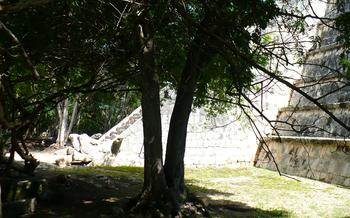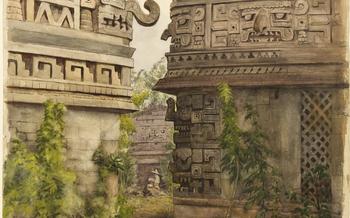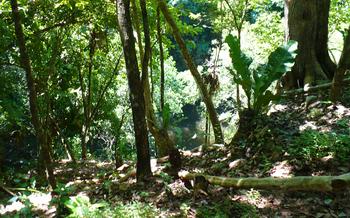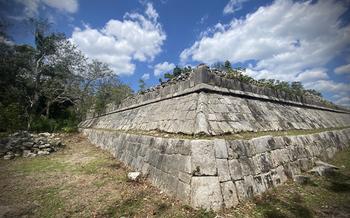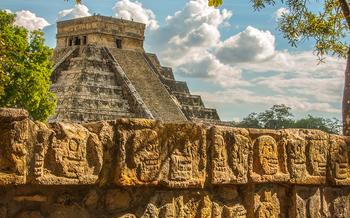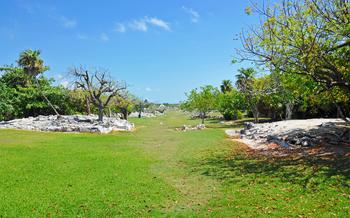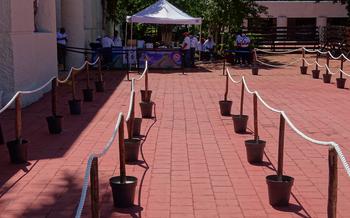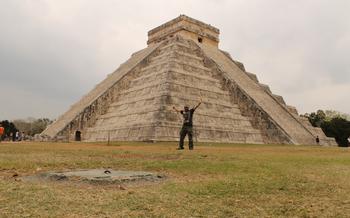
Cenote Tajma Ha
- Chichen Itza and the Cenote Tajma Ha: An Ancient Wonder and a Natural Oasis
- Planning Your Visit to Chichen Itza and the Cenote Tajma Ha
- Exploring the Ancient City of Chichen Itza
- The Cenote Tajma Ha: A Sacred Place of Beauty
- Swimming and Snorkeling in the Cenote Tajma Ha
- Other Activities at Chichen Itza and the Cenote Tajma Ha
- Tips for Responsible Tourism at Chichen Itza and the Cenote Tajma Ha
- Photography Tips for Capturing the Beauty of Chichen Itza and the Cenote Tajma Ha
- Getting to Chichen Itza and the Cenote Tajma Ha
- Cost of Visiting Chichen Itza and the Cenote Tajma Ha
- Accommodation Options Near Chichen Itza and the Cenote Tajma Ha
- Food and Dining Options Near Chichen Itza and the Cenote Tajma Ha
- Budgeting for a Trip to Chichen Itza and the Cenote Tajma Ha
- Safety Tips for Visiting Chichen Itza and the Cenote Tajma Ha
Chichen Itza and the Cenote Tajma Ha: An Ancient Wonder and a Natural Oasis
In the heart of Mexico's Yucatan Peninsula lies a place where history and nature intertwine harmoniously - Chichen Itza, an ancient Mayan city, and the Cenote Tajma Ha, a natural wonder of unparalleled beauty. Chichen Itza, once a thriving metropolis, stands as a testament to the ingenuity and artistry of the Maya civilization. Its iconic structures, such as the Temple of Kukulcan (El Castillo), the Great Ball Court, and the Cenote Sagrado, have captivated the world with their architectural grandeur and cultural significance.
Meanwhile, the Cenote Tajma Ha, a hidden gem nestled within the lush Mayan jungle, offers a breathtaking spectacle of crystal-clear turquoise waters, verdant vegetation, and unique rock formations. This natural wonder holds a special place in Mayan mythology, as it was believed to be a sacred portal to the underworld, a place of communication with the gods. Prepare to be mesmerized as you explore these two extraordinary attractions, each offering a unique glimpse into the rich history and natural beauty of Mexico.
Planning Your Visit to Chichen Itza and the Cenote Tajma Ha
Best time to visit: The best time to visit Chichen Itza and the Cenote Tajma Ha is during the dry season, which runs from November to April. During this time, the weather is generally sunny and dry, making it ideal for exploring the ancient ruins and swimming in the cenote.
Avoiding crowds: To avoid the crowds, it is best to visit Chichen Itza and the Cenote Tajma Ha early in the morning or late in the afternoon. You can also visit during the week, as it tends to be less crowded than on weekends.
Essential items to bring: When visiting Chichen Itza and the Cenote Tajma Ha, be sure to bring sunscreen, water, and comfortable shoes. You may also want to bring a hat, sunglasses, and a swimsuit.
Exploring the Ancient City of Chichen Itza
Chichen Itza, the ancient Mayan city, is a treasure trove of architectural wonders and cultural significance. The most iconic structure is the Temple of Kukulcan, also known as El Castillo, a towering pyramid that dominates the skyline. Its intricate carvings and impressive height are a testament to the ingenuity and craftsmanship of the Maya. The Great Ball Court, the largest in the Americas, is another must-see. Here, the Maya engaged in a ritual ball game that held deep symbolic meaning.
The Cenote Sagrado, or Sacred Cenote, is a natural sinkhole that was considered a sacred place by the Maya. They believed it was a portal to the underworld and used it for religious ceremonies and sacrifices. The cenote's crystal-clear waters and mystical aura make it a popular spot for swimming and snorkeling.
Exploring Chichen Itza is like stepping back in time. The vast plazas, towering temples, and intricate carvings offer a glimpse into the lives and beliefs of the Maya. As you wander through the ancient streets, you can't help but feel a sense of awe and wonder at the achievements of this remarkable civilization.
Personal Experience:
I remember my first visit to Chichen Itza vividly. As I approached the Temple of Kukulcan, I was struck by its sheer size and grandeur. The intricate carvings on the pyramid's facade seemed to come alive in the sunlight, telling stories of a long-lost civilization. Climbing the steep steps to the top was a challenge, but the breathtaking view from the summit was worth every effort. From there, I could see the entire ancient city spread out before me, a testament to the Maya's architectural prowess.
The Cenote Tajma Ha: A Sacred Place of Beauty
Nestled amidst the lush greenery of the Yucatan Peninsula, the Cenote Tajma Ha is a natural wonder that transports visitors to a realm of tranquility and awe. Its crystal-clear waters, vibrant aquatic life, and unique rock formations create an enchanting oasis that has captivated travelers and locals alike for centuries.
This cenote, meaning 'water hole' in the Maya language, holds a special significance for the ancient Maya civilization. Believed to be a sacred place of worship and ritual, the Cenote Tajma Ha was considered a gateway to the underworld, where the Maya believed their ancestors resided.
As you descend the stone steps that lead to the water's edge, you'll be greeted by a breathtaking sight. The cenote's crystal-clear waters shimmer in shades of blue and green, reflecting the vibrant colors of the surrounding vegetation. The walls of the cenote are adorned with intricate rock formations, stalactites and stalagmites that have been sculpted by centuries of water erosion.
Take a moment to soak in the serene atmosphere of the cenote, marveling at the natural beauty that surrounds you. Whether you choose to swim, snorkel, or simply relax on the shore, the Cenote Tajma Ha offers an unforgettable experience that will stay with you long after you've left.
Swimming and Snorkeling in the Cenote Tajma Ha
The Cenote Tajma Ha is not just a place of cultural significance; it is also a beautiful natural wonder that invites visitors to immerse themselves in its refreshing waters. With its crystal-clear visibility, the cenote offers an extraordinary opportunity for swimming and snorkeling.
The water temperature is a pleasant 24 degrees Celsius (75 degrees Fahrenheit) year-round, making it ideal for taking a dip. The cenote's depth ranges from 2 to 10 meters (6 to 33 feet), providing a safe and enjoyable experience for swimmers of all skill levels.
The underwater world of the Cenote Tajma Ha is teeming with life. Snorkelers can expect to encounter a variety of fish species, including colorful damselfish, angelfish, and parrotfish. The cenote is also home to turtles, freshwater eels, and the occasional stingray.
To ensure a safe and enjoyable swimming and snorkeling experience, it is important to follow a few guidelines. First, always wear proper swimwear and water shoes to protect your feet from sharp rocks and coral. Second, be mindful of other swimmers and snorkelers, especially in crowded areas. Third, avoid touching or disturbing the marine life.
My personal experience swimming and snorkeling in the Cenote Tajma Ha was truly unforgettable. The water was crystal clear, allowing me to see the vibrant coral formations and marine life up close. I encountered a playful group of damselfish that swam alongside me, and I even spotted a large turtle gracefully gliding through the water. The experience was both exhilarating and peaceful, leaving me with a deep appreciation for the beauty and wonder of this natural treasure.
Other Activities at Chichen Itza and the Cenote Tajma Ha
Beyond exploring the ancient city and swimming in the cenote, there are several other activities to enjoy at Chichen Itza and the Cenote Tajma Ha. For a subterranean adventure, embark on a guided tour to explore the nearby caves and underground rivers. These tours offer a unique perspective on the region's geology and history, revealing hidden chambers and fascinating rock formations. If you're interested in delving deeper into the cultural significance of Chichen Itza, consider joining a guided tour led by a knowledgeable guide. These tours provide insights into the Maya civilization, their beliefs, and the construction techniques used to create this awe-inspiring city.
Shopping enthusiasts can browse the local markets and shops for souvenirs and traditional Mayan handicrafts. From intricate pottery and colorful textiles to handmade jewelry and souvenirs, there's something for every taste and budget. To savor the local flavors, dine at one of the nearby restaurants and try traditional Mayan cuisine. Indulge in dishes like cochinita pibil, a slow-roasted pork dish, or panuchos, a type of stuffed tortilla. Vegetarian options are also widely available, showcasing the region's fresh produce and culinary creativity.
Tips for Responsible Tourism at Chichen Itza and the Cenote Tajma Ha
As you embark on your journey to Chichen Itza and the Cenote Tajma Ha, it's essential to remember the principles of responsible tourism. This means respecting the cultural and natural significance of the site, minimizing your ecological impact, and supporting local communities. Here are some tips to help you become a responsible traveler:
-
Tread Lightly: Stick to designated paths and avoid touching or climbing on ancient structures. Refrain from picking flowers or disturbing wildlife.
-
Leave No Trace: Dispose of waste properly in designated bins or carry it out with you. Avoid using single-use plastics and opt for reusable water bottles.
-
Respect Local Customs: Dress modestly when visiting sacred sites. Ask permission before taking photos of people, and always be respectful of local customs and traditions.
-
Support Local Businesses: Choose locally-owned restaurants, shops, and tour operators. Purchase souvenirs from artisans and vendors who are part of the community.
-
Be a Cultural Ambassador: Engage with locals, learn about their culture, and share your own experiences. Help break down stereotypes and promote cross-cultural understanding.
Photography Tips for Capturing the Beauty of Chichen Itza and the Cenote Tajma Ha
To capture the grandeur of Chichen Itza and the ethereal beauty of the Cenote Tajma Ha, it's essential to have the right photography gear and techniques. For stunning images, I recommend a camera with a wide-angle lens to capture the expansive views of the ancient city and cenote. A tripod will also come in handy for stable shots, especially in low-light conditions.
When photographing Chichen Itza's structures, focus on capturing their intricate details and imposing presence. Experiment with different angles to create dynamic compositions. For the Cenote Tajma Ha, utilize natural light to highlight the vibrant colors of the water and lush vegetation. Consider using a polarizing filter to reduce glare and enhance the contrast of the water.
To capture the essence of both attractions, I suggest exploring them during different times of the day. The golden hues of sunrise and sunset cast a magical glow on Chichen Itza, while the Cenote Tajma Ha reveals its secrets in the soft light of dawn. With patience and a keen eye, you'll capture memories that will last a lifetime.
Here are some of my personal experiences and anecdotes:
-
During my visit to Chichen Itza, I arrived early in the morning to beat the crowds and capture the rising sun illuminating the Temple of Kukulcan. The warm glow bathed the ancient structure in a golden light, creating a breathtaking scene.
-
At the Cenote Tajma Ha, I spent hours exploring its depths, marveling at the crystal-clear water and vibrant underwater world. Using an underwater camera, I captured stunning shots of the cenote's unique rock formations and playful fish.
-
To capture the Milky Way over Chichen Itza, I ventured out on a clear night and set up my camera on a tripod. The result was a mesmerizing image of the ancient city bathed in the glow of a million stars, a sight that left me in awe.
Getting to Chichen Itza and the Cenote Tajma Ha
Reaching Chichen Itza and the Cenote Tajma Ha is a relatively straightforward journey from major cities in Mexico, such as Cancun, Playa del Carmen, and Merida. Here's how you can get there:
From Cancun:
- By Rental Car: Embark on a scenic self-drive adventure, renting a car from Cancun and enjoying the flexibility of your own transportation. The drive to Chichen Itza takes approximately 2 hours and 30 minutes, following the well-maintained Highway 180.
- By Tour: Join an organized tour from Cancun that combines a visit to Chichen Itza with a refreshing dip in the Cenote Tajma Ha. These tours typically include round-trip transportation, entrance fees, and guided commentary.
- By Public Transportation: Opt for a budget-friendly option by taking a bus from Cancun's ADO bus station to Chichen Itza. Buses depart frequently throughout the day, and the journey takes about 3 hours. From Chichen Itza, take a taxi or colectivo (shared van) to the Cenote Tajma Ha, located just a few kilometers away.
From Playa del Carmen:
- By Rental Car: Rent a car from Playa del Carmen and take a leisurely 2-hour drive to Chichen Itza, enjoying the coastal views along the way.
- By Tour: Book a guided tour from Playa del Carmen, which usually includes transportation, entrance fees, and a knowledgeable guide to enhance your experience.
- By Public Transportation: Take a bus from Playa del Carmen's ADO bus station to Chichen Itza, a journey of approximately 2 hours and 30 minutes. From Chichen Itza, hop on a taxi or colectivo to reach the Cenote Tajma Ha.
From Merida:
- By Rental Car: Embark on a road trip from Merida, renting a car and following the well-paved Highway 180. The drive to Chichen Itza takes about 1 hour and 30 minutes.
- By Tour: Join a guided tour from Merida, which typically includes round-trip transportation, entrance fees, and informative commentary about the region's history and culture.
- By Public Transportation: Take a bus from Merida's CAME bus station to Chichen Itza, a journey of approximately 2 hours. From Chichen Itza, take a taxi or colectivo to the Cenote Tajma Ha.
Whichever mode of transportation you choose, ensure you plan your journey in advance, especially during peak tourist season, to avoid any last-minute surprises or inconveniences.
Cost of Visiting Chichen Itza and the Cenote Tajma Ha
Visiting Chichen Itza and the Cenote Tajma Ha involves certain costs, but with careful planning, you can have a budget-friendly experience. The entrance fee to Chichen Itza is around 25 USD, and the Cenote Tajma Ha charges a separate entrance fee of approximately 10 USD. Additional expenses include transportation, food, and any guided tours you may wish to take.
To save money on transportation, consider taking public buses or colectivos from nearby cities, which are a cost-effective option. Food expenses can be managed by opting for local eateries and street food vendors, which offer delicious and affordable meals. Guided tours can be expensive, but they provide valuable insights into the history and culture of Chichen Itza. If you're on a tight budget, consider exploring the sites independently with the help of a guidebook or online resources.
Personal Experience:
During my trip, I managed to keep my expenses in check by opting for local transportation and budget-friendly accommodation. I packed snacks and drinks to minimize food costs and splurged on a guided tour to gain a deeper understanding of Chichen Itza's history. By planning and prioritizing, I had a fulfilling experience without breaking the bank.
Accommodation Options Near Chichen Itza and the Cenote Tajma Ha
There is a wide range of accommodation options available near Chichen Itza and the Cenote Tajma Ha, catering to various budgets and preferences. For those seeking a luxurious and immersive experience, the Hacienda Chichen Resort and Yaxkin Spa offers a blend of traditional Mayan architecture with modern amenities. Travelers on a budget can opt for the Hotel Maya Inn or the Hostal Chichen Itza, which provide comfortable and affordable accommodations. For backpackers and adventure enthusiasts, the Mayan Monkey Hostel offers a lively atmosphere and opportunities to meet fellow travelers.
When choosing your accommodation, consider factors such as proximity to the ruins and cenote, amenities, budget, and personal preferences. Make sure to book your accommodation in advance, especially during peak tourist season, to avoid disappointment.
Food and Dining Options Near Chichen Itza and the Cenote Tajma Ha
The region surrounding Chichen Itza and the Cenote Tajma Ha is known for its vibrant culinary scene, showcasing a blend of traditional Mayan cuisine and modern Mexican flavors. Whether you're looking for a quick bite or a memorable fine-dining experience, there are plenty of options to satisfy your taste buds.
For an authentic taste of Mayan cuisine, try the local specialty, cochinita pibil, a slow-roasted pork dish cooked in banana leaves with achiote paste. Panuchos, fried tortillas filled with refried beans and topped with cochinita pibil, are another must-try.
If you prefer seafood, indulge in the freshest catches of the day at one of the many seafood restaurants near the cenote. From grilled lobster to ceviche, there's something for every palate.
For a unique dining experience, head to one of the many cenote restaurants, where you can enjoy a meal surrounded by the natural beauty of the cenote. These restaurants often offer a more upscale menu, featuring innovative dishes that incorporate local ingredients and flavors.
No matter your budget or preferences, you'll find plenty of delicious food options near Chichen Itza and the Cenote Tajma Ha. Be sure to sample the local specialties and enjoy the vibrant culinary scene that this region has to offer.
Personal Experience:
During my visit to Chichen Itza, I had the opportunity to try several local dishes, including cochinita pibil and panuchos. The flavors were incredible, and I especially enjoyed the cochinita pibil, which was tender and flavorful. I also visited a cenote restaurant, where I had a delicious meal while surrounded by the stunning scenery of the cenote. It was a truly unique and memorable dining experience.
Budgeting for a Trip to Chichen Itza and the Cenote Tajma Ha
Planning a trip to Chichen Itza and the Cenote Tajma Ha requires careful budgeting to ensure you have a comfortable and enjoyable experience. Here's a detailed breakdown of the estimated costs to help you create a realistic budget:
Transportation:
- From Cancun or Playa del Carmen: Round-trip transportation by bus or shuttle ranges from $20 to $50 per person. For a more personalized experience, consider renting a car for around $50 to $80 per day.
Accommodation:
- Budget-friendly hostels or guesthouses near Chichen Itza start at around $15 to $25 per night. Mid-range hotels with more amenities typically cost between $50 to $100 per night. For a luxurious stay, expect to pay $150 or more per night.
Food and Dining:
- Local restaurants and eateries offer affordable options with dishes ranging from $5 to $15. Fine dining experiences at upscale restaurants can cost $25 to $50 or more per person.
Activities and Entrance Fees:
- The entrance fee to Chichen Itza is $60 for foreigners and $120 for non-Mexican visitors. Snorkeling or diving in the Cenote Tajma Ha typically costs between $10 to $25 per person, depending on the package. Additional activities like guided tours, cave exploration, or shopping for souvenirs should be factored into your budget.
Other Expenses:
- Sunscreen, water, and comfortable shoes are essential items that can add up over the course of your trip. Allocate some extra funds for unexpected expenses like tips, laundry, or medical needs.
Tips for Saving Money:
- Opt for budget-friendly accommodation and transportation.
- Pack your own snacks and drinks to avoid overspending on food and beverages at tourist sites.
- Take advantage of discounts and promotions offered by tour operators or local businesses.
- Cook your own meals if possible to save on dining costs.
- Explore the hidden cenotes near Chichen Itza, which often have lower entrance fees or are free to visit.
Safety Tips for Visiting Chichen Itza and the Cenote Tajma Ha
Visiting Chichen Itza and the Cenote Tajma Ha is generally safe, but it's essential to take precautions to ensure a smooth and enjoyable experience. Here are some safety tips to keep in mind:
-
Be aware of your surroundings: Chichen Itza is a popular tourist destination, so it's important to be vigilant and aware of your surroundings. Keep an eye on your belongings and be wary of pickpockets.
-
Avoid walking alone at night: It's best to avoid walking alone at night, especially in the parking lots or along the roads. If you need to go somewhere at night, take a taxi or have a friend accompany you.
-
Be careful when swimming in the cenote: The cenote's waters are generally safe for swimming, but it's essential to be cautious. Be aware of the depth of the water and any potential hazards, such as slippery rocks or underwater currents.
-
Respect the local customs and traditions: Chichen Itza is a sacred site for the Maya people, so it's important to be respectful of their customs and traditions. Avoid climbing on the ruins or taking any artifacts.
-
Be prepared for the heat: The weather in Chichen Itza can be hot and humid, so it's essential to stay hydrated and wear sunscreen. Wear light, comfortable clothing and a hat to protect yourself from the sun.
-
Don't drink the tap water: The tap water in Chichen Itza is not safe to drink, so it's essential to drink bottled water or purified water.
-
Be aware of the wildlife: Chichen Itza is home to various wildlife, including snakes, spiders, and scorpions. Be aware of your surroundings and avoid touching or disturbing any animals.
-
Be prepared for crowds: Chichen Itza is a popular tourist destination, so it's essential to be prepared for crowds, especially during peak season. Arrive early to avoid the crowds, or visit during the off-season.
